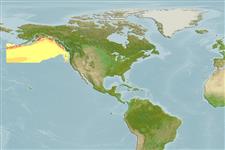Klassifizierung / Names
Namen | Synonyme | Catalog of Fishes(Gattung, Arten) | ITIS | CoL | WoRMS | Cloffa
>
Perciformes/Cottoidei (Sculpins) >
Liparidae (Snailfishes)
Etymology: Paraliparis: Greek, para = the side of + Greek, liparis = fat (Ref. 45335); bullacephalus: Named for its large, round head covered with gelatinous tissue; from Latin words 'bulla' meaning bubble and 'cephalus' for head..
Environment: milieu / climate zone / depth range / distribution range
Ökologie
seewasser bathypelagisch; tiefenbereich 233 - 322 m (Ref. 82595). Temperate
Gulf of Alaska.
Size / Gewicht / Alter
Maturity: Lm ? range ? - ? cm
Max length : 6.2 cm SL Männchen/unbestimmt; (Ref. 82595); 9.4 cm SL (female)
Kurzbeschreibung
Morphologie | Morphometrie
Rückenflossenweichstrahlen (insgesamt): 60; Afterflossenweichstrahlen: 53 - 55; Wirbelzahl: 63 - 64. The species is distinguished from its congeners by the following set of characters: D 60; A 53-55; pectoral-fin rays 20-21; caudal-fin rays 6; vertebrae 63-64; dorsal contour of head rounded to snout, covered with gelatinous tissue; short snout with rounded tip projecting past upper jaw; small mouth, horizontal, inferior, with cleft reaching to nearly vertical below center of eye; large eye with dorsal margin level with or slightly above top of gill
opening; large opercular flap, rounded, projecting slightly toward dorsal; upper lobe of pectoral fin with 15 rays, one in
notch, and 4 or 5 in lower lobe, both lobes extending beyond anal-fin origin; cephalic pores are equal to or smaller in diameter than nostril; suprabranchial pore elevated, anterior of gill opening a distance about equal to opercular flap width; 3 pyloric caeca (Ref. 82595).
The male (5.30 and 6.20 cm) specimens appear to be mature, while the female (9.40 cm) was mature with ovaries containing numerous mature and immature, spherical, pale-colored, opaque, yolked oocytes, ranging in diameter from 0.20-2.12 mm; from gross observation, there appear to be fewer than 100 eggs in each ovary. Specimens were collected with a 60 cm bongo net, epibenthic sled and bottom trawl (Ref. 82595).
Life cycle and mating behavior
Geschlechtsreife | Fortpflanzung | Ablaichen | Eier | Fecundity | Larven
Busby, M.S. and R.L. Cartwright, 2009. Paraliparis adustus and Paraliparis bullacephalus: two new snailfish species (Teleostei: Liparidae) from Alaska. Ichthyol. Res. 56:245-252. (Ref. 82595)
IUCN Rote Liste Status (Ref. 130435)
Bedrohung für Menschen
Harmless
Nutzung durch Menschen
Mehr Information
NamenSynonymeMetabolismusRäuberÖkotoxikologieFortpflanzungGeschlechtsreifeAblaichenSpawning aggregationFecundityEierEientwicklung
Alter/GrößeWachstumLänge-GewichtLänge-LängeLängenhäufigkeitenMorphometrieMorphologieLarvenLarven Pop.Dyn.RekrutierungDichteBRUVS
ReferenzenAquakulturAquakultur ProfilZuchtlinienGenetikElectrophoresesVererbbarkeitKrankheitenVerarbeitungNutrientsMass conversion
PartnerBilderStamps, Coins Misc.LauteCiguateraGeschwindigkeitSchwimmstilKiemenoberflächeOtolithsGehirngrößeSehfähigkeit
Tools
Zusatzinformationen
Download XML
Internet Quellen
Estimates based on models
Preferred temperature (Ref.
123201): 4.1 - 6.4, mean 5.1 °C (based on 9 cells).
Phylogenetic diversity index (Ref.
82804): PD
50 = 0.5000 [Uniqueness, from 0.5 = low to 2.0 = high].
Bayesian length-weight: a=0.00525 (0.00237 - 0.01161), b=3.15 (2.96 - 3.34), in cm total length, based on LWR estimates for this (Sub)family-body shape (Ref.
93245).
Trophic level (Ref.
69278): 3.4 ±0.5 se; based on size and trophs of closest relatives
Widerstandsfähigkeit (Ref.
120179): hoch, Verdopplung der Population dauert weniger als 15 Monate. (Preliminary K or Fecundity.).
Fishing Vulnerability (Ref.
59153): Low vulnerability (10 of 100).
